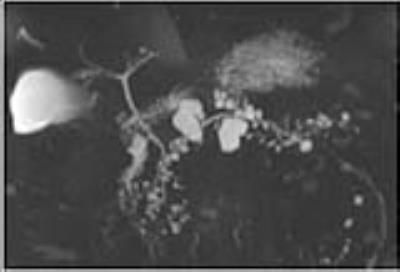Pancreas
1Radiology, Memorial Sloan Kettering, New York, NY, United States
Synopsis
Overview
Magnetic resonance imaging (MRI) and cholangiopancreatography (MRCP) offer multiple advantages in the management of patients with pancreatic diseases. While CT remains the workhorse for routine abdominal imaging, MRI is increasingly used for specific pancreatic indications and in the evaluation of patients at risk for pancreatic cancers. Since MRI is more expensive and more time consuming than CT, its use should be supported by its added value, such as superior diagnostic accuracy, lack of ionizing radiation, or novel contrast mechanisms.
In this session, we will review the role of MRI in characterizing and monitoring pancreatic cysts, and in evaluating patients for pancreatic cancers. We will also explore the promise of diffusion weighted imaging (DWI) for pancreatic diseases.
Pancreatic Cysts
Up to 20% of patients who undergo MRCP have incidental pancreatic cysts. Many centers now perform a majority of their MRCP to follow-up pancreatic cystic lesions. Management guidelines have been published to aid radiologists in assessing the risk of cancer in patients with pancreatic cysts, and intraductal papillary mucinous neoplasms (IPMN) in particular. We will review the pathophysiology of IPMN, illustrate current guidelines for this disease, compare MRI to other imaging modalities, and identify limitations in current techniques.Pancreatic cancer
The mortality of pancreatic adenocarcinoma remains high as patients are often diagnosed at later stages. Efforts at early detection remain at the forefront of strategies to curb pancreatic cancer related-deaths. MRI is routinely used as a screening tool for patients at high risk for pancreatic cancer, such as those with a strong family history or with BRCA mutations. The optimal screening strategy, currently a combination of endoscopic ultrasound and MRCP, remains under investigation. We will compare MRI to CT, both in the setting of screening for pancreatic cancer and in the staging of patients with known or suspected pancreatic adenocarcinoma.
Diffusion Weighted MR Imaging
DWI offers unique soft tissue contrast capabilities, not available to CT or endoscopic ultrasound, in the evaluation of pancreatic diseases. We will review its potential role in assessing pancreatic cystic lesions and a mimic of pancreatic cancer: autoimmune pancreatitis. In addition to routinely available DWI, reduced field-of-view DWI, intravoxel incoherent motion (IVIM) and diffusion tensor imaging will be explored as additional tools for evaluating the pancreas. Finally, we will review limitations in the reproducibility of DWI and IVIM parameters in pancreatic diseases.Acknowledgements
Dr. Lorenzo MannelliReferences
Tanaka M, Pancreatology. 2012 May-Jun;12(3):183-97.
Canto MI, Gastroenterology. 2012 Apr;142(4):796-804.
Treadwell JR, Pancreas. 2016 Jul;45(6):789-95.
Kang KM, Radiology. 2014 Feb;270(2):444-53.
Mannelli L, Radiol Clin North Am. 2015 May;53(3):569-81
